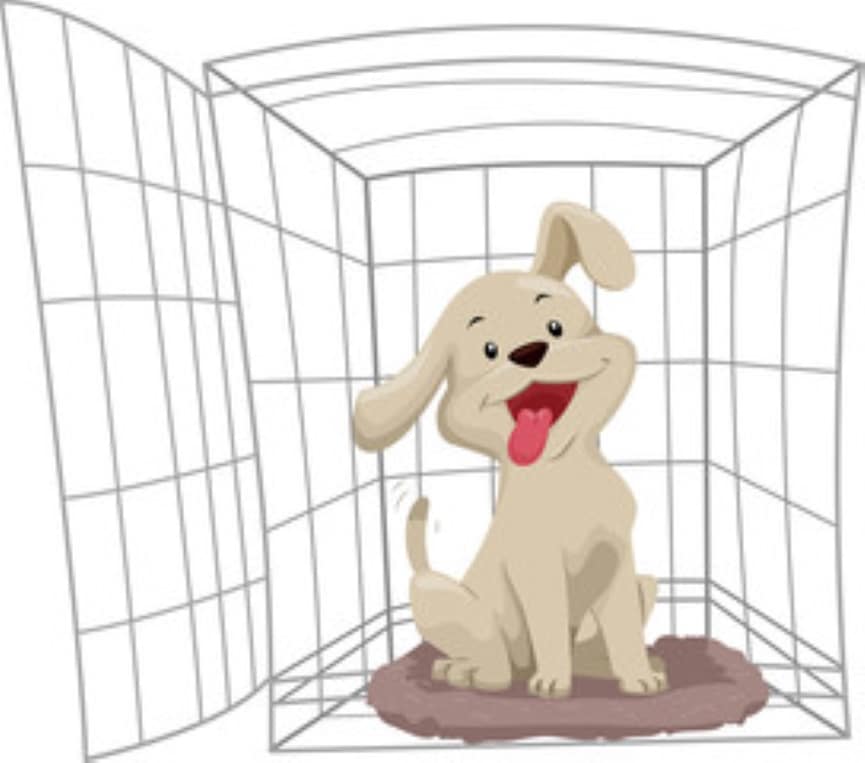A Puppy's Prison?
Or a Doggy's Domain?
While crate training has it’s critics, most of the controversy stems from inappropriate training or use. When done correctly, a crate can provide a safe place for your dog that they will find comfort in. Even if you don’t care to use a crate to potty train a puppy, there are many instances where your dog may need to be crated, such as travel or in some facilities. It’s a skill your dog should have.

Step One- Get The Right Crate
The crate is not a cage to keep your dog in, it’s a personal space for your dog, ideal for sleep and security for periods of time. As such, it needs to be a comfortably small space, appropriately sized for your puppy. You don’t want a crate large enough where the puppy can use the bathroom on one end, and nap at the other, yet the dog crate needs to be large enough for them to comfortably stand up in and sit down, with a door big enough for them to climb through. Since your puppy will grow, you can avoid buying multiple crates over time by buying the adult sized crate, and using fillers to narrow the space to the correct size.
There is no standard sizes, so its best to measure your dog and go by the dimensions of the crate. For a general guide:
Weight of puppy: Crate Size:
<25lb 18-25″
35-40lb 30-36″
40-80lb 36-45″
>80lb 50-60″
Step Two- Make It Comforable
You want the crate to be a place your puppy feels comfortable and safe. Adding a soft blanket, or stuffed animal, can go a long way towards that.
Step Three- Introduce Your Puppy
It’s important that you build a positive association to the crate for your puppy. So for starters, you want your puppy to walk in the crate on his own. Placing a treat inside usually does the trick. Allow your puppy to walk in and out of the crate, using rewards. After a few times, close the crate door for a minute, and then open it. This is just an introduction, so keep it short and sweet.
Step Four- Acclimate Your Puppy
Crate your puppy for short intervals of time, gradually increasing the duration, so they can get adjusted to the crate with growing confidence that it isn’t a confinement, but a place of their own, like a bed. If done correctly, you will see your dog relaxing in his crate of his own accord during the day as the door is open.
DO:
- Wear your puppy out with an incredible playtime before putting them up for bed. Especially their first few nights; they will be away from their littermates, in a new environment. It’s very common for them to cry. But a cozy bed, when exhausted can help minimize their distress.
- Reward your puppy for being in the crate calmly, and bring happy excited energy with you to the crate.
- Keep their crated intervals to a minimum during the day at first, a few minutes at a time for training, and at nap times only.
DONT:
- Put your puppy in the crate by force, or as punishment. They can read your emotions, so avoid putting them in their crate while frustrated or angry. This will create a negative experience and change what the crate represents
- Leave your puppy in the crate for extended periods of time. Particularly early on. You want them to feel safe, not trapped. At night, it’s okay because they are sleeping. If you work during the day, you should leave the crate open, and puppy proof the room or area they are in if you can’t arrange for someone else to let them out.
Common Questions:
My puppy is already older, is it too late to crate train?
No. Ideally, you start early. But you can crate train your dog at any time. If your dog is older and used to a different routine, be sure to really reward them during the training process as they are more likely to feel like uncomfortable by the change and smaller space, having become accustomed to a different routine. Heavier rewards can help offset the negative experience from the initial the transition.
My puppy is crying for hours, is this normal?
Some whining and squirming will happen inevitably as they settle in to the routine. The younger your puppy, the more likely they will cry. In addition to the steps outlined here, you can try adding white noise, or a stuffed animal to snuggle against. They snuggle with their siblings for the first 8 weeks of sleeping, it’s a big change for them.
My puppy is potty trained, should I still crate train them?
Yes. There are enough scenarios where you might need to crate your dog, that you should equip them with the ability to relax in a crate. It might not be their routine to sleep in one, but they should be able to be crated without being traumatized by the confinement. Otherwise, you may find yourself needing to crate your dog for travel, hospitals, or emergencies, and wish you had.


